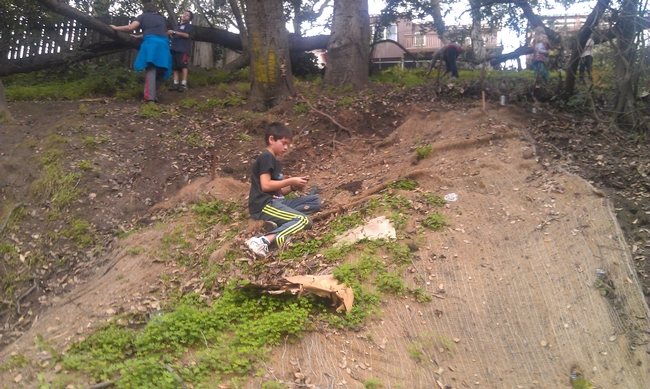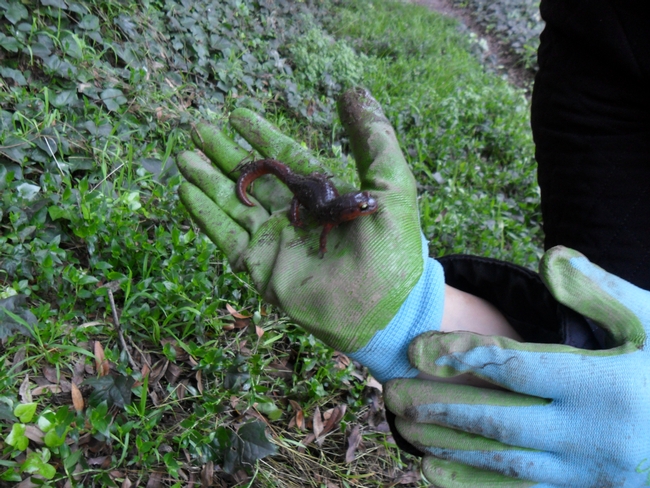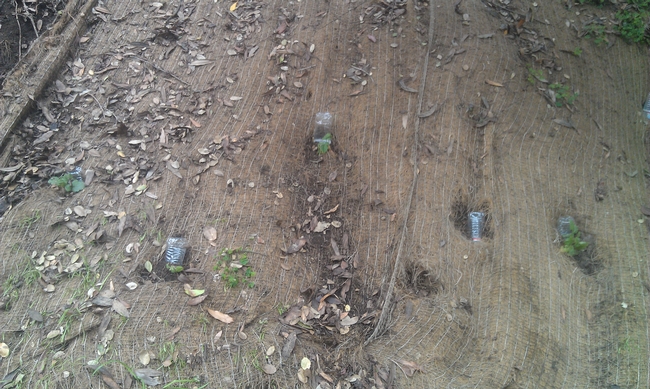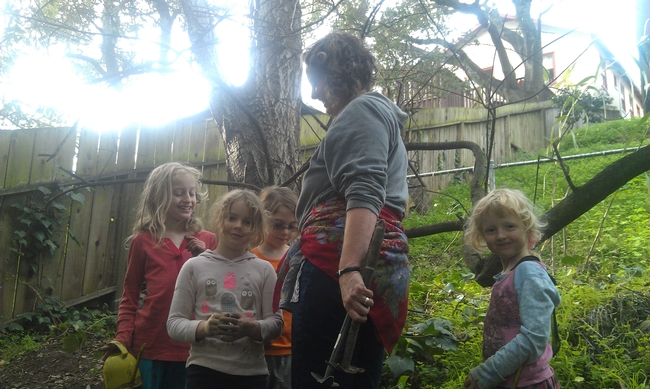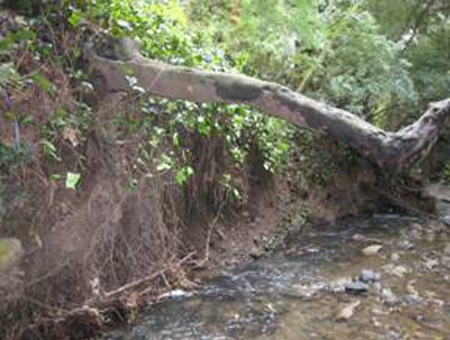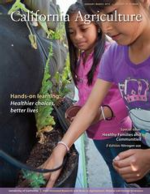Posts Tagged: communities
4-H club restores Sausal Creek with native plants
When it comes to protecting the environment, 4-H members are not afraid to get their hands dirty. For the past few years, a 4-H club in Oakland has been working in partnership with the Friends of Sausal Creek to transform a section of hiking trail that had become overgrown with nonnative, invasive plant species.
Since adopting the stretch along Sausal Creek in Dimond Park in 2012, 20 4-H members ranging from 5 to 12 years old have been pulling out the invasive plants and replacing them with native plants.
“Friends of Sausal Creek provides us with all the plants and gives us guidance on what should go where,” said Genesta Zarehbin, the 4-H adult volunteer leading the project.
“We planted lots of native plants, such as strawberries, bee plant, ninebark, iris-leaf rush, wood rush, and thimbleberry, that look really cool — but it still gives the appearance of more ivy and spiderwort,” said Zarehbin, who lives in Oakland.
The creek is the 4-H project's outdoor classroom, where participants can learn about native plant species, their characteristics and uses, all while performing a community service. They also take part in fun learning activities related to the restoration project, such as scavenger hunts.
“They have field journals and do research to complete a plant page,” Zarehbin said. “The younger kids do observation -- how many leaves does it have? What color is it? How tall is it? It's a natural discussion when you're out there.”
After removing the invasive, nonnative plants, the 4-Hers had the opportunity to redesign the stretch of trail by choosing and planting natives. At monthly meetings held at the creek, the members regularly weed, water and mulch the plants and pick up trash.
“My kids really get into it,” said Zarehbin, whose children include 9- and 11-year-old sons and twin 6-year-old daughters. “They recognize cow parsnip and soaproot when we go out on hikes. In some areas they'll say, ‘This looks like people are taking care of it.' It gives them a sense of place and how humans shape the environment.”
“The first year, everything died,” said Zarehbin. “The second year, we supplemented the water, and we have a number of plants that survived.”
The creek project is educating the 4-H members, and the 4-H members, in turn, are educating park visitors about the vital work of protecting our natural resources.
“Since our work site is in a very visible location, our 4-H members have been able to enlist the assistance of community members and they frequently have the opportunity to share information with curious onlookers,” said the 4-H project leader.
Zarehbin appreciates the autonomy that Friends of Sausal Creek has allowed, something that enables the kids to develop a sense of ownership. “They let the kids control how they want things to look,” she explained. “The Friends of Sausal Creek are willing to work with young kids and let them work hands-on and contribute in a meaningful way.”
The organization often leads middle school and high school students on field trips, but 4-H is one the few long-term relationships they have with younger children.
Friends of Sausal Creek, which manages a 2600-acre watershed with two permanent full-time staff members, depends on the help of others to preserve and protect the creek.
Groups typically work on an adopted site a few times a year, whereas the 4-H members tend to their site at least once a month. At the last 4-H work day, 30 people participated, said Zarehbin.
“Their recurring workdays enable them to maintain the site – weeding around the native plants and watering them until they are established,” said McAfee. “Their work helps to increase the biodiversity in these urban wildlands.”
McAfee hopes the kids' enthusiasm for nurturing the natural environment will spread to other people in the community.
“The 4-H site is a highly visible one, located across Sausal Creek from the Dimond Park tot lot and community center,” she said. “The kids' ongoing stewardship and dedication to their site can inspire other members of the community. We love the connection the kids get to their public lands by tending their site over time.”
Every year the 4-H club hosts an Earth Day event for a local public school to share what they're learning with other kids their age. Last year, 90 students from Sequoia Elementary School participated, making nature-based crafts and pulling invasive plants to widen the trail. This year the 4-H members have invited Glenville Elementary to join them at Dimond Park on March 12 from 11 a.m. to 1 p.m.
To learn more about participating in 4-H in Alameda and Contra Costa counties, contact May McMann, 4-H program representative at mmcmann@ucanr.edu or (925) 646-6543. To find a UC Cooperative Extension 4-H club near you, visit http://4h.ucanr.edu/Get_Involved/County.
For more than 100 years, the University of California Cooperative Extension researchers and educators have been drawing on local expertise to conduct agricultural, environmental, economic, youth development and nutrition research that helps California thrive. UC Cooperative Extension is part of the University of California's systemwide Division of Agriculture and Natural Resources. Learn more at ucanr.edu.
UC initiative to help youth improve health, education and science literacy
Original research and literature reviews on these subjects appear in the January-March 2013 California Agriculture, UC’s peer-reviewed research journal of research in agriculture, natural and human resources (http://www.californiaagriculture.ucanr.edu).
UC Agriculture and Natural Resources (ANR) has launched a strategic initiative to help California youth. Called Healthy Families and Communities, it includes research and programs to encourage healthy lifestyles, boost science literacy, and foster positive youth development. Delaine Eastin, former State Superintendent of Public Instruction, notes, “At the end of the day, the Healthy Families and Communities Strategic Initiative is about change, scientifically measurable change, yielding concrete evidence of youth improvement due to these efforts.”
The facts underlying the initiative are startling. Nearly half of the state’s adults could be obese by 2030, according to a 2012 report by the nonprofit Trust for America’s Health. Obesity is linked to chronic illnesses, such as type 2 diabetes, heart disease and high blood pressure.
In addition, each year about 100,000 California youth who reach graduation age fail to graduate from high school, a predictor of their future social and financial difficulties as well as a missed opportunity for training skilled workers to replace those close to retirement. Finally, California’s eighth-grade science scores ranked 47th among the states in the National Assessment of Educational Progress’s 2011 report. A workforce with the knowledge and skills for scientific careers is critical to the state’s economy, and to full participation in today’s technological society.
Confronting these complex issues requires a multifaceted approach that leads to strategic change, says David Campbell, UC Cooperative Extension specialist in the Department of Human and Community Development at UC Davis and leader of ANR’s new youth-focused initiative.
“We’re bringing a lot of people together across disciplines,” he says. “If our work is going to be relevant to the real world, we need to reflect its complexity.”
As part of the initiative, UC researchers are partnering with schools and youth organizations in controlled studies to learn what works in the real world.
Summaries of projects and links to articles:
Integrating local agriculture into nutrition programs can benefit children's health (page 30). Sheri Zidenberg-Cherr, UCCE specialist in the Department of Nutrition at UC Davis, leads a K-6 nutrition education effort, called Shaping Healthy Choices. Designed to both improve child health and support local agriculture, the program incorporates serving regional fruits and vegetables, a school garden, and classroom nutrition and physical fitness lessons. In this controlled four-year study, investigators have matched schools in Northern and Central California, and will compare those that are implementing the program with those that are not.
Communitywide strategies key to preventing childhood obesity (page 13). According to Pat Crawford, UCCE specialist in the Department of Nutritional Science and Toxicology at UC Berkeley, increasing consumption of fruits and vegetables is important but not enough by itself to combat obesity. Two of the strongest factors driving obesity are sweetened beverages and fast food, and decreasing their consumption is just as important as increasing the consumption of healthy foods. “You have to do both,” she says.
Her team at the Center for Weight and Health in Berkeley, with funding from ANR, is evaluating Team Up for Good Health, a community-based approach to preventing obesity in elementary school children. Investigators are studying fourth- and fifth-grade participants in school and after-school obesity prevention programs, using body mass index (BMI) reductions after two years as a measure of success.
Lessons of Fresh Start can guide schools seeking to boost student fruit consumption (page 21). In 2005, California became the first state to address the availability of fresh and local produce in the federal School Breakfast Program through state funding. This evaluation of the California Fresh Start program reveals lessons that are especially important now, as schools across the country prepare to increase the number of fruits and vegetables offered in the School Breakfast Program by July 2014 as part of the Healthy, Hunger-Free Kids Act.
Inquiry-based learning (pages 47 and 54). Another innovative aspect of these UC programs is the curriculum. Based upon inquiry-based learning, it captures the attention of students by focusing on the real world and children’s day-to-day lives. For example, in the Shaping Healthy Choices program (page 30), a lesson on food labels at school will be followed by students comparing food labels on their own, at home and in grocery stores. “Application is what makes learning stick,” says Martin Smith, UCCE specialist in the School of Veterinary Medicine who works on youth science literacy. “Inquiry-based learning takes longer, but it’s deeper — kids own the knowledge because they figured it out themselves.”
Positive youth development merits state investment (page 38). A team of UC researchers reviews studies supporting a new paradigm for youth programs, and proposes increased state investment in this area. Research over the last 30 years has shifted thinking away from the deficit model, in which researchers and practitioners considered high-risk youth behaviors to be their focus, and toward promotion of positive patterns. “Far too many California youth are not thriving,” the authors note. “Promotion of healthy pathways to college, work and community engagement is of urgent concern.” They cite findings that positive youth development is linked to improved school achievement, higher graduation rates, and fewer risk behaviors.
The entire January-March 2013 issue can be downloaded at http://californiaagriculture.ucanr.edu.
California Agriculture is the University of California’s peer-reviewed journal of research in agricultural, human and natural resources. For a free subscription, go to: http://californiaagriculture.ucanr.edu, or write to calag@ucanr.edu.
WRITERS/EDITORS: To request a hard copy of the journal, e-mail crllopez@ucanr.edu.

